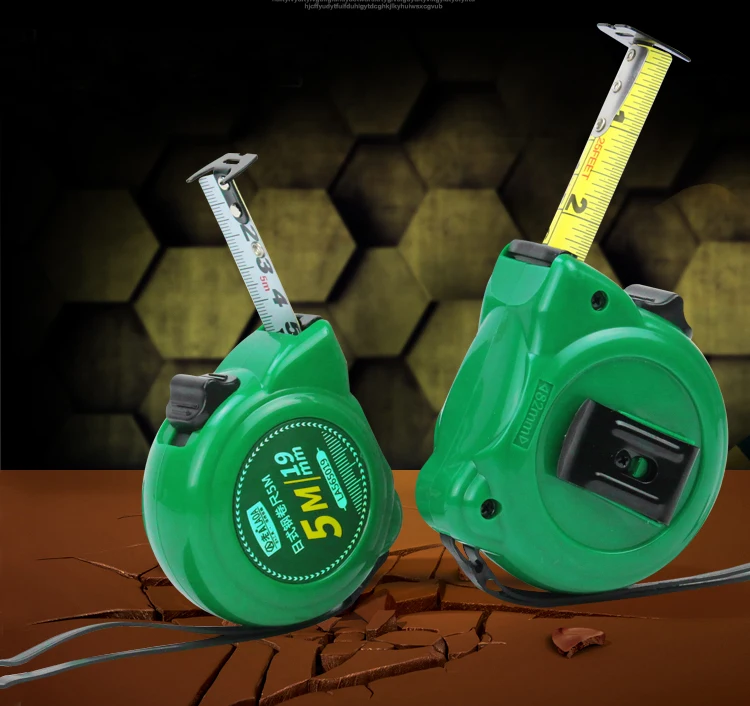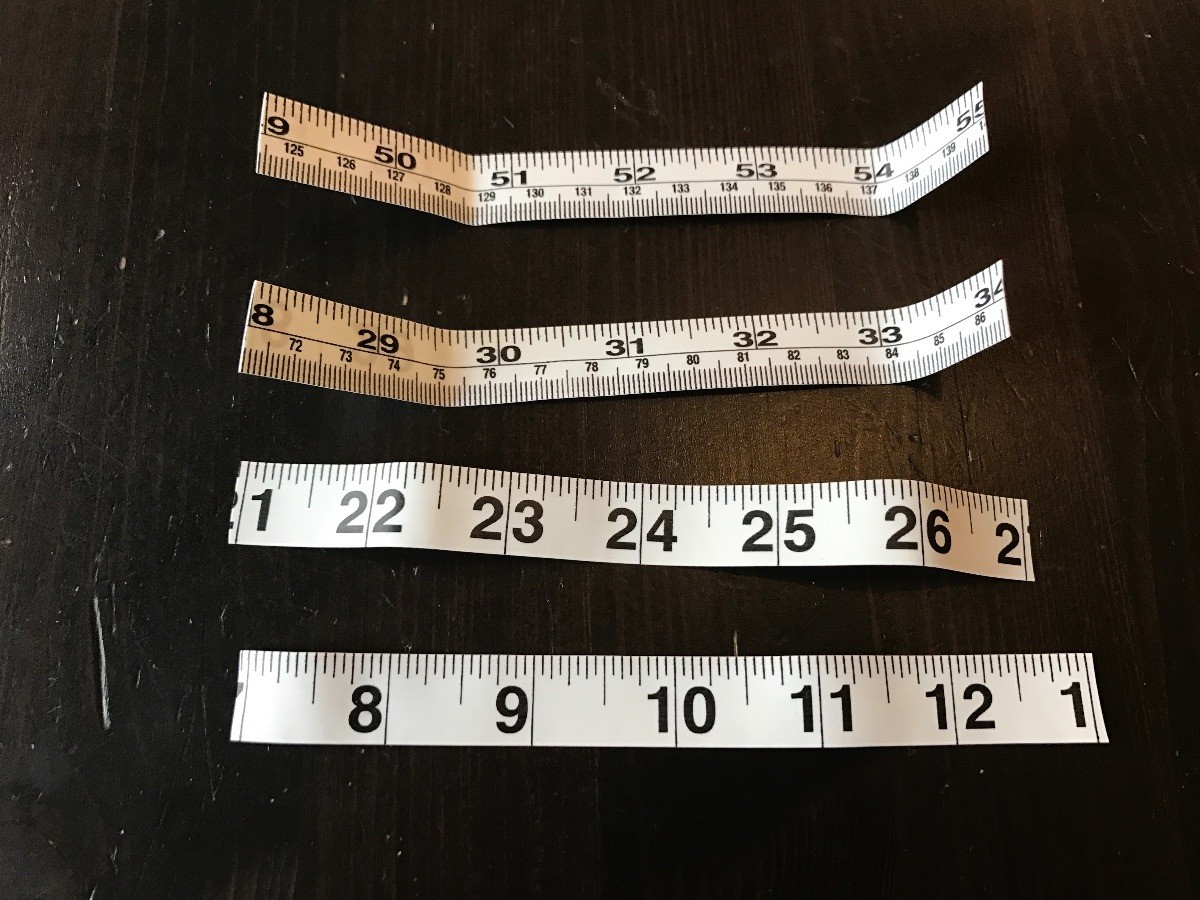Small Measurements On A Tape Measure In the US, the standard tape measure will measure in Imperial units—that's feet and inches—while the rest of the world uses metric tape measures to measure in meters and centimeters. No matter which measurement system your measuring tape follows, the basic anatomy of the tool and how to read it remain the same. In the US, the standard tape measure will measure in Imperial units—that's feet and inches—while the rest of the world uses metric tape measures to measure in meters and centimeters. Tape measures are often designed for specific uses or trades. Tapes may have different scales, be made of different materials, and be of different lengths depending on the intended use. Tape measures that were intended for use in tailoring or dressmaking were made from flexible cloth or plastic.
These types of tape measures were mainly used for the measuring of the subject's waist line. Today, measuring tapes made for sewing are made of fiberglass, which does not tear or stretch as easily. This type of tape measure will have a floating tang or hook on the end to aid measuring. The tang is connected to the tape with loose rivets through oval holes, and can move a distance equal to its thickness, to provide both inside and outside measurements that are accurate. A tape measure of 25 or even 100 feet can wind into a relatively small container. The self-marking tape measure allows the user an accurate one hand measure.
A tape measure usually has two different measurement systems on it. This is a mix of the inch system and the metric system. Most manufacturers have opted to use both systems, for whatever reason. Even though modern-day measurements are usually taken in inches, some do not, so the calibrations stay. The top half of a tape measure is usually in inches, broken into eighth and sixteenth of an inch increments. The bottom half of the tape is divided into centimeters and millimeters.
The large numbers on the top represent inches, while the little marks between the numbers represent increments of an inch mentioned earlier. For example, a 16-foot tape measure has 16-1 foot markers across the top and inch marks . A tape measure, or measuring tape is a type of hand tool typically used to measure distance or size. It is like a much longer flexible ruler consisting of a case, thumb lock, blade/tape, hook, and sometimes a belt clip.
A tape measure will have imperial readings, metric readings or both. They are a common measuring tool used in both professional trades and simply around the home. Most standard tape measures in the U.S. have markings that measure down to 1/16 of an inch. These are smaller, sometimes thinner markings, evenly spaced between the half-inch and inch marks on a tape measure.
On some tapes, quarter inch marks are the same size as eighth-inch marks. Remember that two sixteenths of an inch equals one eighth, two eighths of an inch equals one quarter, and 2 quarters equals one half. For example, the second eighth-inch marking after the inch marking is a quarter inch. Reading a tape measure correctly is a necessary skill when taking on DIY projects. Tape measures are available in both standard or imperial units and in metric units.
This guide will show you how to read a tape measure. Plus, you'll learn some tips and tricks for using this tool to get precise measurements. A standard tape measure will have all the same markings as an easy read measuring tape, but will only have labels for the large 1″ marks. This is typically why people new to reading measuring tapes find it hard to know what measurement they're actually looking at.
Imperial measurement can be a bit tricky, especially or those who have been brought up using Metric measurement. The Imperial measure used extensively in the US, is split to feet, inches and fractions of an inch. The next is the 1/8th of an inch with a slightly longer hash mark. These are longer again, and 2/8ths, 4/8ths, and 6/8ths are marked as quarter inches.
The ½ inch is marked with a yet longer hash, and then each inch is marked with a hash that runs across the width of the measure, and a number. As we know, 12 inches make up a foot, and these are marked with 1F, 2F, 3F, and so on. Sometimes you will find that on one edge that after the foot marker, the inches will increase again by single digits to reach 12 for a the next foot. On the other edge the inches will keep numbering incrementally, so 1ft 2 inches will register as 14 inches, and so on. At three feet, for example, it would measure 36 inches.
In some countries such as the UK, tape measures have both Imperial and Metric measurement markings. Until recently in the US, for example, all tape measures were in Imperial units, however the dual standard option is becoming more widely available. We've owned and used this standard tape measure for years and have been very happy with it.
Once you learn what the markings mean (see our next section!) this type of measuring tape will be easy to read too. The nice thing about them is the 1″ marks are much larger and easier to read than the easy read tape measure option discussed above. Reading a tape measure is a skill you can easily master. Using this small, sturdy hand tool can improve the accuracy of your project measurements. Learning how to use a tape measure properly means to always "measure twice, cut once." You can use a standard tape measure or opt for a metric one.
The Home Depot delivers online orders when and where you need them. Understand that a metric tape measures use centimeters instead of inches. Each centimeter is divided into ten sections called millimeters.
All you have to do is read the larger lines and then number of millimeters of the last centimeter if the object does not measure an exact number of centimeters. Flexible, vinyl measuring tapes are typically used for sewing and fabric, but I've used them for measuring round objects in our DIY or home improvement projects before as well. Like the standard tape measures, these only label the 1″ marks along the tape and require you to understand how to read a tape measure. The sale of dual Metric/US Customary scale measuring tapes is slowly becoming common in the United States. For example, in some Walmarts there are Hyper Tough brand tapes available in both US customary units and Metric units. So, the inclusion of a metric scale requires the measuring device either to contain 3 scales of measurement or the elimination of one of the US Customary scales.
The lines on a tape measure are simple to read once one understands what they represent. The longest lines represent the number of inches from the beginning of whatever space is measured. This is usually a different color than the other numbers. The bigger marks between each inch mark represent one-half of an inch. The markings between each half-inch mark represent a quarter of an inch, while the markings between each quarter-inch represents 1/8 of an inch. Between these 1/8 inch marks are 1/16 inch marks, with some tape measures breaking the inch down into 32nds and even 64ths.
Just as you would with a retractable tape measure, look for the spot where the end of the object or distance you're measuring lines up with the tape measure. If the tape measure stretches exactly halfway between the 27 and 28 inch markings, this means that your arm is 27.5 inches long. You might be one of those people who just think the hook at the end of the tape measure is so you can easily roll the end of the reel. Well, it's a much more sophisticated than meets the eye. The hook is called the 'tang', and is attached to the blade of the tape measure using a couple of rivets. However, if you have noticed the tang is not held in a permanent position, and floats at the end with a little give.
This little piece of shaped metal, makes measuring an internal measurement just as easy as taking an external. By pushing the tang up to an internal edge it butts up tight to the end of the tape measure blade to give an accurate reading. You will see a foot designation marked every 12 inches . A 16-foot tape measure, for example, will have sixteen one-foot marks along its length and 192 one-inch marks . Each inch will have eight 1/8 inch marks and sixteen 1/16 inch marks.
In many cases these measurements are abbreviated, so 6 ′ 4 1/4 ″ means six feet four and a quarter inches. To write the measurement, the task will be easy if the object measures in approximate inch-values. However, if there is deviance from 1-inch markings to smaller ones, keep a calculator handy to add the fractions. Or display the might of your mental math for accurate tape measurement values. The weakest part of any tape measure is the blade, and the PowerLock's is more durable than nearly all the others' we tested.
The thumb-operated blade lock is smooth, strong, and easy to operate with one hand, unlike some other more cumbersome models. It's a basic tool whose pared-down simplicity makes it light, tough, accurate, easy to handle, and affordable. Taking all this into consideration to name the tool that gives you the best value, the other tapes—which often cost more—all fell short compared to this one.
An easy read tape measure has the most dimension details on the tape, making the reading of your measurement easier to recognize and quite possibly quicker. Short tapes, sometimes referred to as pocket tape measures or pocket measuring tapes, are the most common type of tapes on the market today. With countless millions sold throughout the world every year and hundreds of manufacturers producing them, these are what most people would think of if asked to describe a tape measure. To read a measuring tape, line the zero mark up at the edge of the item you're measuring, then stretch the tape all the way across the item.
Try to keep the tape straight to ensure an accurate measurement! Then, look at the point where the tape meets the end of the item you're measuring and read the nearest large number. The large numbers are the units you're measuring, like inches or centimeters, and the markings between the large numbers correspond to fractions of that unit. Building and construction practice calls for all measurements to be made in millimeters .
These are the smallest unit on the tape measure scale, and are also marked with the smalles hash mark along the edge. As they are so small, they are generally not individually numbered on tape measures. Ten millimeters make up a centimeter and these are marked with a number, and a bigger hash mark. Every tenth centimeter is highlighted, so they can be easily picked out. A hundred centimeters make up a meter , which is again clearly marked on a tape measure with a hash mark that will extend across the width. If you want a wider, tougher tape and don't mind a higher price and a bigger, harder to manage tool, the Stanley FatMax 25-foot tape measure is a great choice.
Personally I much prefer this type of measuring tapes for sewing. Converting lengths for sewing is simple using a tailor's tape marked in both cm and inch. All you need to do is read the inch side corresponding to the number in centimeters.
If we have to convert for example 66 cm into inches, looking at the image below we can see the result is 26 inches. The use of millimeter only tape measures for housing construction is a part of the US metric building code. Millimeters produce whole numbers, reduce arithmetic errors, thus decreasing wastage due to such errors. On a tape measure labeled with imperial units, the most prominent marks are usually the one-inch marks.
These are typically marked by long, thin lines and fairly large numbers. In the image below a pocket tape measure is presented, in which generally, they use the metric and imperial system on the same sheet. The measurements at the bottom of the tape are metric units, they are in centimeters and millimeters . There are 10 mm in each centimeter and 100 cm in each meter.
For measurements on construction sites or in industry, tape measures made of steel or glass fiber plastic are mainly used. If the model is made of steel, the scale is not printed on, but is usually engraved – so it cannot wear out. Depending on the length, the scale shows units such as meters, decimeters, centimeters and millimeters.
When I started to sew and for a long time afterwards I just knew the main marks in the tape measure. Something as basic as this should be taught in the school rather than some other nonsense that I learned in school, which I never found a use afterwards. In this age of laser measuring tapes , electronic tape measures and measuring tape apps , and easy paper patterns one may wonder at the use of the ordinary tape measures. But for me it is one of the most useful and necessary sewing tool. Starrett long and short measuring tapes and Measure Stix™ are offered in a wide range of styles and sizes. Graduations are available in English and Metric to meet virtually every requirement for accurate tape measurement.
Introducing the new series of Starrett, Starrett Exact® and Starrett Exact® Plus. For this guide, we only looked at tapes with traditional locking buttons. Some companies make tape measures with auto-locking features that automatically hold the tape in place once it is extended. A button, located where the normal toggle would be, retracts the tape. It makes sense to just learn that little trick and then have the full range of tape motion if you need it.
In addition to the easy read and standard tape measures discussed above, there are a few other non-traditional measuring tapes you can use for projects too. But if you DO end up needing or using a metric tape measure, know that for every meter, there are 100 cm and for every cm, there are 10 mm. Most metric measuring tapes only mark the cm for readability, so you'll need to count the number of ticks in between to get your exact measurement. Sometimes, there are larger ticks in between each cm to denote 1/2 cm.
In the United States, the imperial measurement system is normally used on a tape measure, though some models may have both the imperial and the metric system. They generally come with hard pieces of metal on the ends to make it easy to place the tape at the exact location where you need to start measuring. What is the smallest measurement on a tape measure?
The smallest marks on a tape indicate one millimeter or 1/10th of a centimeter. The large, bold markings on a metric tape measure indicate centimeters. The long mark in the center indicates a half-centimeter. To read a metric measuring tape, find the nearest whole centimeter to the end point. Standard or SAE tape measures clearly show feet, inches and fractions of inches.






















No comments:
Post a Comment
Note: Only a member of this blog may post a comment.